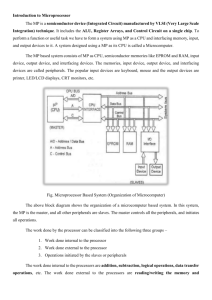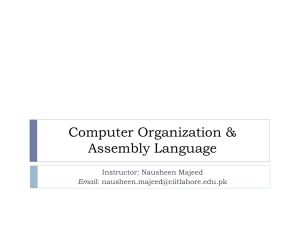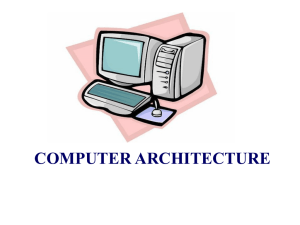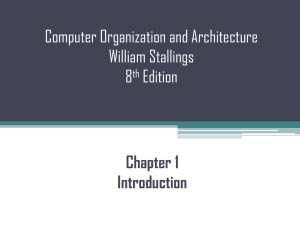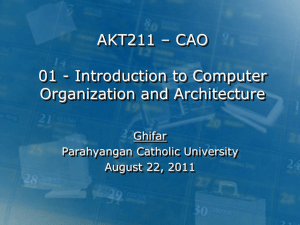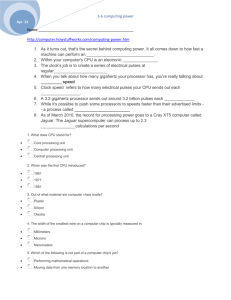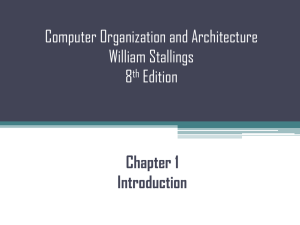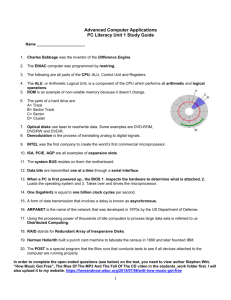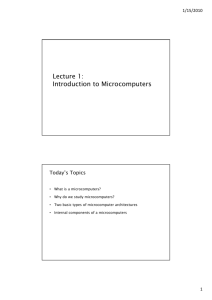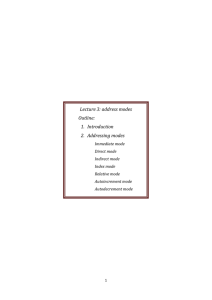Machine and Assembly Language Programming
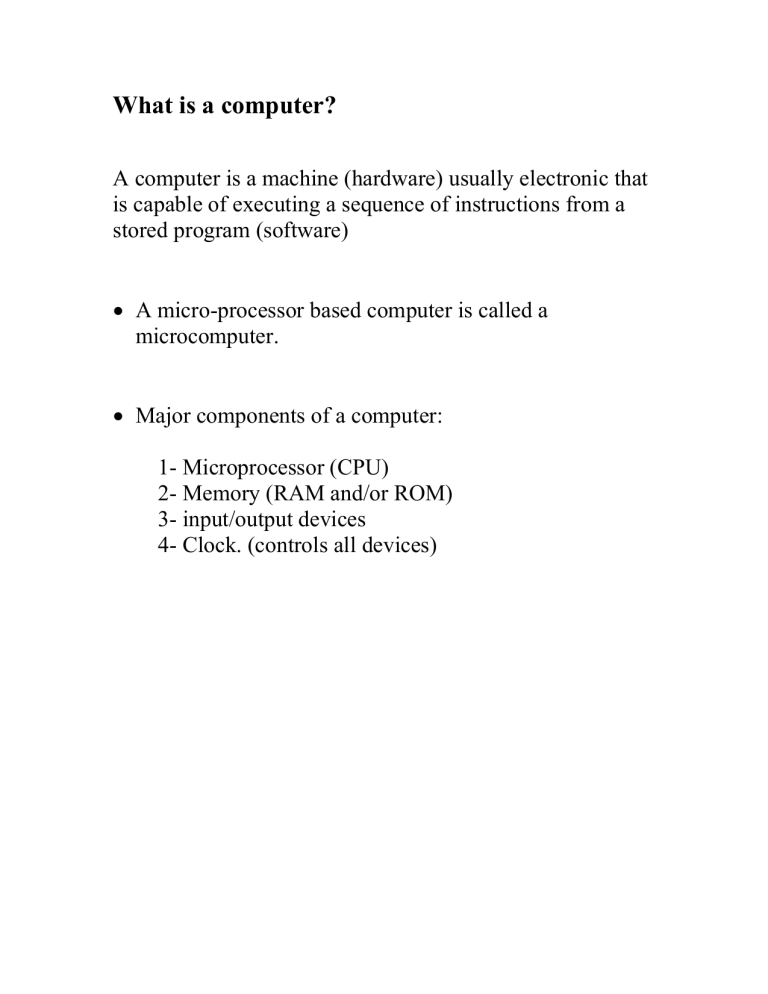
What is a computer?
A computer is a machine (hardware) usually electronic that is capable of executing a sequence of instructions from a stored program (software)
A micro-processor based computer is called a microcomputer.
Major components of a computer:
1- Microprocessor (CPU)
2- Memory (RAM and/or ROM)
3- input/output devices
4- Clock. (controls all devices)
Microprocessor
Register
File
Input Devices
CLOCK
ALU
Main Memory
Control
Unit
Output Devices
Block Diagram of A Typical Microprocessor
Microprocessor
Contains the following main components:
ALU
Carries out the arithmetic functions of the computer.
Also it performs the logical functions.
Control Unit
Is the “brain” of the computer. Determines which
function to be done on data, decodes instructions, and
controls the flow of the program
Register File
These are high speed storage locations. Hold internal data that the processor currently using while executing programs.
Two kinds of registers exist:
1- Special purpose registers
Used by CPU. Most important are the program counter (PC), and the processor status register.
2- General purpose registers
Used by programmers
Main Memory
A linear list of memory cells. Each cell holds a data word.
A word could be a byte (ex. VAX), 2 bytes, 4 bytes ..... address
0 b p-1
...................b
0
1 .
2 .
.
.
. n-3 . n-2 . n-1 .
memory unit of n cells
All memories share two organizational features:-
1) Each information unit is the same size.
2) An information unit has a numbered address
associated with it by which it can be uniquely
referenced.
A memory cell is characterized by two things:-
1) An address
2) Content
The basic memory cell on many computers including the
VAX holds one byte (8 bits). Such machines are called byte-addressable. Other machines have larger storage units.
Components of the computer are connected by Buses.
A bus in the simplest form is a set of wires that used to carry information in the form of electrical signals between CPU and memory and CPU and I/O
There are 3 buses in the system
- Data Bus
- Address Bus
- Control (signal) Bus
VAX has a 32-bit address bus and a 32-bit data bus
Computer Architecture
The architecture of a computer system is the user-visible interface: The structure and operation of the system as seen by the programmer. It includes
- The instruction set the computer can obey
- The ways in which the instructions can specify the
locations of data to be processed
- The type and representation of data
- The format in which the instructions are stored in
memory
Most modern computers follow the Von Neuman
Architecture : This architecture is based on the stored program concept. The program to be executed along with the data on which it operates are stored in a memory device attached to the processor.
Instruction Set Architectures
A computer’s hardware has a small, fixed number of operations, or instructions that it can perform. This is called the instruction set of the machine. It is defined by the manufacturer.
We will be concerned with the following issues:
Operand storage in CPU
Where are operands kept other than in memory?
- Number of explicit operands named per instruction
How many operands are named explicitly in a typical instruction?
- Operand location (addressing modes)
Can any ALU instruction operand be located in memory or must some or all of the operands be in internal storage in the CPU? If an operand is located in memory, how is the memory location specified?
- Operations
What operations are provided in the instruction set?
- Type and size of operands
What is the type and size of each operand and how is it specified?
Instruction Set
The instruction set of a microprocessor is the collection of all the machine instructions that the processor can obey.
Types of instructions
- Data movements
- Arithmetic/ logic
- Control (modify the execution order)
Instruction Execution
A computer is controlled by a program, which is a sequence of instructions. Each instruction specifies a single operation to be performed by the CPU ex.
ADD R7, ALPHA
Instructions are stored in memory along with the data on which they operate.
The processor FETCHES and instruction from memory,
INTERPRETS what function is it to be performed, and
EXECUTES the function on its operands (data)
This is called the instruction fetch/execute cycle
Operands
fetch
Instruction Instruction
fetch execution
Instruction Cycle store
result
Interrupt
processing
All instructions are composed of two components
1.
An operation code (OPCODE) that specifies the function to be performed.
2.
One or more operand specifiers that describe the locations of the information units on which the operation is performed.
A computer by itself can’t do anything. It needs software. A sequence of instructions called a program, makes the computer work.
Microprocessors by themselves only react to patterns of electrical signals.
These patterns comprise what we call a machine language
, which consists of the binary patterns of 0’s and 1’s that represent the signals the CPU understand.
Machine language is machine dependent and varies from model to model of computers.
ex.
0000 0100 0110 0111 1001 111 000 0100 1100 0000 on the VAX means add the integer 6 to the integer stored at memory location 467
“1100 0000” is the code for add instruction on the VAX
The machine designers decide on these codes and patterns when designing the machine.
Programming in machine language is very difficult and tedious.
A better way is needed to write programs, so Assembly language and high-level language were introduced
Assembly Language
Is a symbolic code that allows mnemonics for machine language instructions and symbolic names for memory locations. ex. instead of using “1100 000”, we write the symbol
ADD to mean the same thing
It is a programming language in which instructions correspond closely to the individual machine instructions that are carried by a particular computer. So assembly language, like machine language, is machine dependent
The VAX/VMS assembly language is called MACRO
Assembly language uses symbols to represent the operation codes while a special notation is used to represent the different addressing modes.
A translator is used to translate the assembly code into machine code. This translator is called an assembler .
The name of the assembler we will use is MACRO.
Level 5 High level language level
Translation (compiler)
Level 4 Assembly language level
Translation (assembler)
Level 3 Operating system level partial interpretation (O/S)
Level 2 Conventional machine level
Interpretation (microprogram)
Level 1 Microprogramming level
Level 0 Hardware level
Microprograms are directly executed by the hardware
Multilevel Machine
Computer Hardware
System Software O/S
Application Software
End Users
The most important system software is the operating system, which is an integrated system of programs that manages the system resources, and provides various support services such as the computer executing the application programs of users.
Major Categories of Programming Languages:
Machine Language (First-generation Language)
Most basic level of programming languages. Uses
binary coded instruction.
Assembly Language (Second-generation Language)
They are sometimes called symbolic languages, because
symbols are used to represent operation codes and
storage locations.
High-Level Languages (Third-generation Languages)
Use instructions called statements, that closely resemble human language or standard notation of mathematics.
Fourth-generation Languages
A variety of programming languages that are more nonprocedural and conversational. The programmers specify the result they want, while the computer determines the sequence of instructions that will accomplish these results. Ex. SQL ex.
SUM = SUM * 2 + ALPHA/3;
in C
MULL3 SUM, #2, R6
DIVL3 #3, ALPHA, R7
ADDL3 R6, R7, SUM each one of the above instructions will correspond to one machine instruction. (a pattern of 1’s and 0’s)
Mnomonics Assembler Object source code (MACRO) code
HLL source Compiler Object code code
What’s is right with assembly language?
Speed
- Assembly language programs are generally the fastest programs around.
- Machine language created by compilers are usually longer and slower.
Space
Assembly language programs are often the smallest.
Capability
- You can do things in assembly which are difficult or
impossible in HLLs.
- Applications requiring access to low level machine
capability are often written in assembly language
ex. device drivers.
Knowledge
- Your knowledge of assembly language will help you write better programs, even when using HLLs.
- Assembly language requires learning the architecture
of the specific machine on which assembly language
is used
High-Level vs. Low-level languages
An LLL requires long sequences of instructions to perform a complex task.
An HLL provides complex statements that perform complex jobs. ex. the for loop in C or other languages
An LLL is machine dependent. Every microprocessor has its own assembly language. (instruction set dependent)
An HLL is not machine dependent (compilers are)
What about JAVA?
Programmers must know the internal structure of the microprocessor, ex. number of registers, and how to use them
An HLL provides a high level of abstraction from the hardware details. Hides the internal structure of the processor.
Reduced Instruction Set Computers (RISC) vs.
Complex Instruction Set computer (CISC)
Characteristics of CISC (ex. VAX)
1.
Large number of instructions
2.
some instructions that perform specialized tasks and are used infrequently
3.
large variety of addressing modes
4.
variable length instruction format
5.
instructions that manipulate operand in memory
- Characteristics of RISC (ex. SPARC)
1.
few instructions
2.
few addressing modes
3.
memory access limited to load/store instructions
4.
all operations done within the registers
5.
fixed length instruction format
6.
single cycle instruction execution

